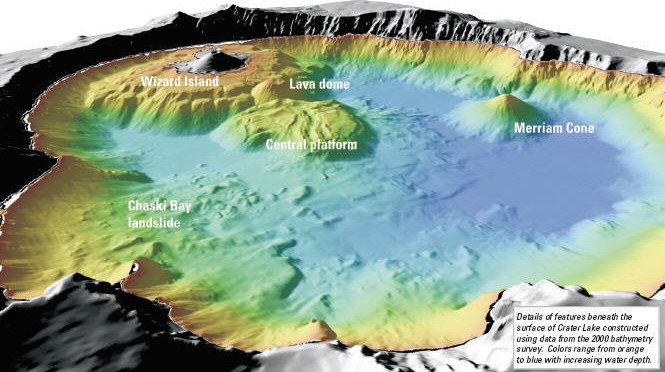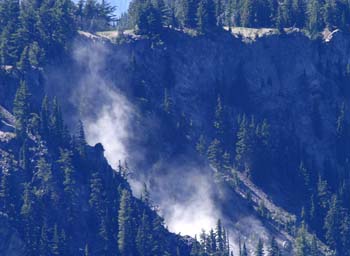Rock slides and landslides are a common occurrence at Crater Lake National Park, especially within the caldera rim of Crater Lake. If you wait for long or frequent the rim, you are bound to see one.
|
A rock slide within the Crater Lake caldera rim wall, Crater Lake National Park, photo by Robert Mutch |
Many factors contribute to the downward movement of the rock debris. Most important is melt-water derived from snow that accumulates to great thicknesses on the rock walls. This gives lubricating and hydraulic action for the removal of fine rock particles that support larger debris. Once a slide is started, more material of all sizes is dislodged along the paths. These tumble and bounce from one rock ledge to another, breaking off the edges, filling crevices crossed enroute, cutting their way through snow fields, and only stopping far below. Winds blowing against the walls also loosen fine particles which are supporting more massive material and help to start rock movement. Scurrying movements of small animals and tremblors caused by the rumbles of vehicles passing on the road, by thunder, or by distant slides are other contributing factors. [Active Rock Slides – Nature Notes From Crater Lake, Henry E. Kane, Vol. 16 – 1950]
Mass Wasting Articles in Nature Notes From Crater Lake
- Redcloud Rock Slide – L. T. Grose, Vol. 13 – October 1947
- The Crumbling Rim – Ernest G. Moll, Vol. 8 No. 1 – July 1935
- How Fast Is The Rim Retreating? – Earl W. Count, Vol. 6 No. 2 – July 1933
- The Receding Rim Of Crater Lake – D. L. Evans, Vol. 5 No. 2 – August 1932
- Spring Slides On Talus Slopes – L. D. Leslie, Vol. 2 No. 1 – July 1929
- Unusual Ridges Of Rock Fragments – Carl E. Dutton, Vol. 8 No. 1 – July 1935
- The Future Wizard Peninsula – L. T. Grose, Vol. 13 – October 1947
- The Pinnacles – D. S. Libbey, Vol. 4 No. 3 – September 1931
- Repeat Photography and Landscape Change – Ron Mastrogiuseppe and John Salinas, Vol. 28, 1997 – repeat photography for erosional changes
- Look Out Below! – Earl U. Homuth, Vol. 1, No. 3, 1928
- My Kingdom for a Horse – D. S. Libbey, Vol. 4, No. 2, 1931
- Views From Sinnott Memorial – Willis G. Downing, Vol. 21, 1955
Other pages in this section
*** previous title *** --- *** next title ***



